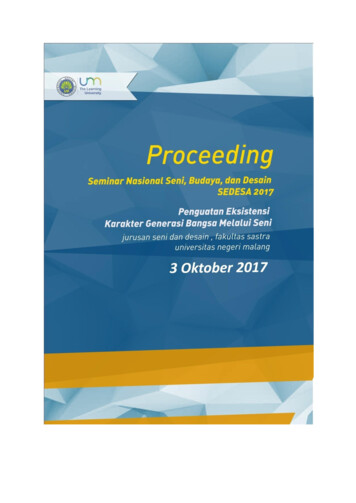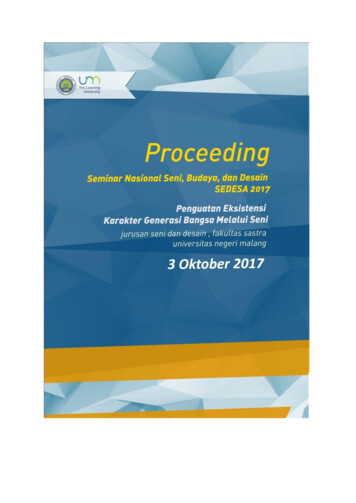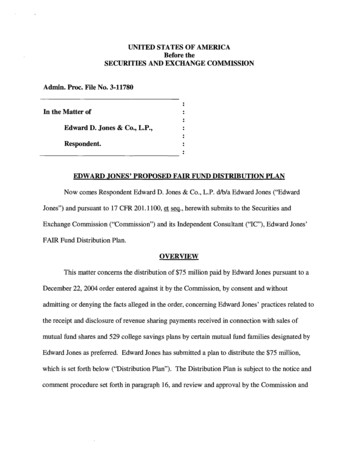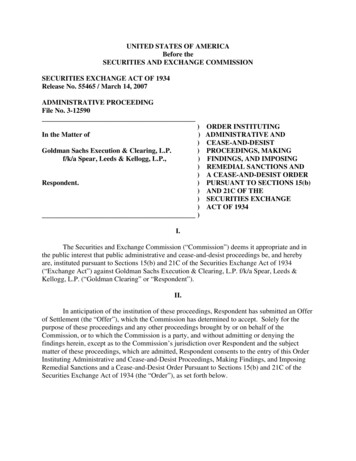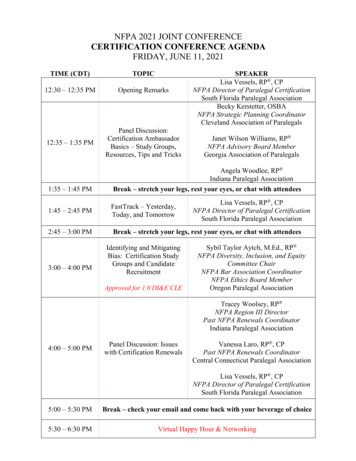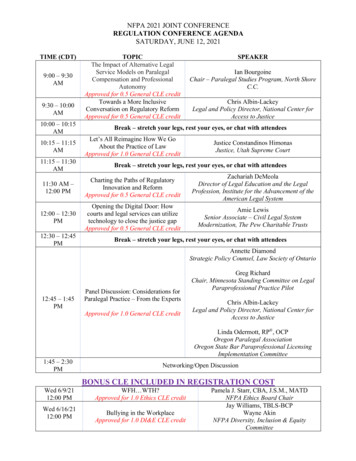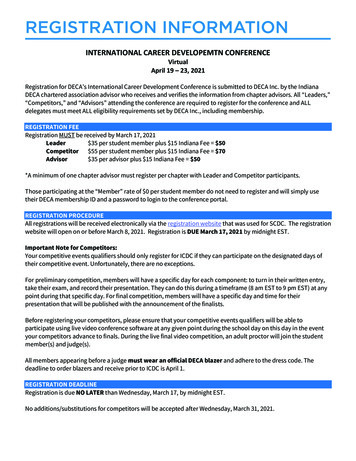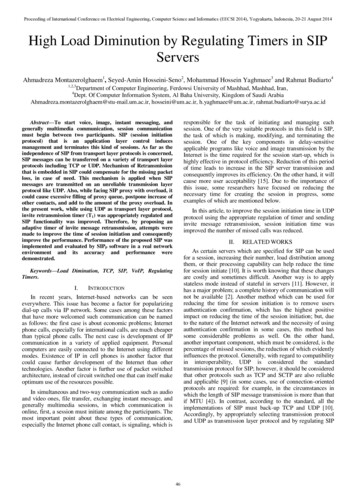
Transcription
Proceeding of International Conference on Electrical Engineering, Computer Science and Informatics (EECSI 2014), Yogyakarta, Indonesia, 20-21 August 2014High Load Diminution by Regulating Timers in SIPServersAhmadreza Montazerolghaem1, Seyed-Amin Hosseini-Seno2, Mohammad Hossein Yaghmaee3 and Rahmat Budiarto41,2,3Department of Computer Engineering, Ferdowsi University of Mashhad, Mashhad, Iran,Dept. Of Computer Information System, Al Baha University, Kingdom of Saudi ArabiaAhmadreza.montazerolghaem@stu-mail.um.ac.ir, hosseini@um.ac.ir, h.yaghmaee@um.ac.ir, rahmat.budiarto@surya.ac.id4responsible for the task of initiating and managing eachsession. One of the very suitable protocols in this field is SIP,the task of which is making, modifying, and terminating thesession. One of the key components in delay-sensitiveapplicable programs like voice and image transmission by theInternet is the time required for the session start-up, which ishighly effective in protocol efficiency. Reduction of this periodof time leads to increase in the SIP server transmission andconsequently improves its efficiency. On the other hand, it willcause more user acceptability [15]. Due to the importance ofthis issue, some researchers have focused on reducing thenecessary time for creating the session in progress, someexamples of which are mentioned below.Abstract—To start voice, image, instant messaging, andgenerally multimedia communication, session communicationmust begin between two participants. SIP (session initiationprotocol) that is an application layer control inducesmanagement and terminates this kind of sessions. As far as theindependence of SIP from transport layer protocols is concerned,SIP messages can be transferred on a variety of transport layerprotocols including TCP or UDP. Mechanism of Retransmissionthat is embedded in SIP could compensate for the missing packetloss, in case of need. This mechanism is applied when SIPmessages are transmitted on an unreliable transmission layerprotocol like UDP. Also, while facing SIP proxy with overload, itcould cause excessive filling of proxy queue, postpone increase ofother contacts, and add to the amount of the proxy overload. Inthe present work, while using UDP as transport layer protocol,invite retransmission timer (T1) was appropriately regulated andSIP functionality was improved. Therefore, by proposing anadaptive timer of invite message retransmission, attempts weremade to improve the time of session initiation and consequentlyimprove the performance. Performance of the proposed SIP wasimplemented and evaluated by SIPP software in a real networkenvironment and its accuracy and performance weredemonstrated.In this article, to improve the session initiation time in UDPprotocol using the appropriate regulation of timer and sendinginvite message retransmission, session initiation time wasimproved the number of missed calls was reduced.II. RELATED WORKSAs certain servers which are specified for SIP can be usedfor a session, increasing their number, load distribution amongthem, or their processing capability can help reduce the timefor session initiate [10]. It is worth knowing that these changesare costly and sometimes difficult. Another way is to applystateless mode instead of stateful in servers [11]. However, ithas a major problem; a complete history of communication willnot be available [2]. Another method which can be used forreducing the time for session initiation is to remove usersauthentication confirmation, which has the highest positiveimpact on reducing the time of the session initiation; but, dueto the nature of the Internet network and the necessity of usingauthentication confirmation in some cases, this method hassome considerable problems as well. On the other hand,another important component, which must be considered, is thepercentage of missed sessions, the reduction of which evidentlyinfluences the protocol. Generally, with regard to compatibilityin interoperability, UDP is considered the standardtransmission protocol for SIP; however, it should be consideredthat other protocols such as TCP and SCTP are also reliableand applicable [9] (in some cases, use of connection-orientedprotocols are required: for example, in the circumstances inwhich the length of SIP message transmission is more than thatif MTU [4]). In contrast, according to the standard, all theimplementations of SIP must back-up TCP and UDP [10].Accordingly, by appropriately selecting transmission protocoland UDP as transmission layer protocol and by regulating SIPKeywords—Load Diminution, TCP, SIP, VoIP, RegulatingTimers.I.INTRODUCTIONIn recent years, Internet-based networks can be seeneverywhere. This issue has become a factor for popularizingdial-up calls via IP network. Some cases among these factorsthat have more welcomed such communication can be namedas follows: the first case is about economic problems; Internetphone calls, especially for international calls, are much cheaperthan typical phone calls. The next case is development of IPcommunication in a variety of applied equipment. Personalcomputers are easily connected to the Internet using differentmodes. Existence of IP in cell phones is another factor thatcould cause further development of the Internet than othertechnologies. Another factor is further use of packet switchedarchitecture, instead of circuit switched one that can itself makeoptimum use of the resources possible.In simultaneous and two-way communication such as audioand video ones, file transfer, exchanging instant message, andgenerally multimedia sessions, in which communication isonline, first, a session must initiate among the participants. Themost important point about these types of communication,especially the Internet phone call contact, is signaling, which is46
Proceeding of International Conference on Electrical Engineering, Computer Science and Informatics (EECSI 2014), Yogyakarta, Indonesia, 20-21 August 2014every stage of invite retransmission, the amount of timer A willbe doubled in order to increase the probability of receiving thereply, which will continue (for 7 times) so that timer B will beterminated; this timer is equivalent to 64 times of timer T1according to the following formula:timers, some conditions can be provided for increasing theprotocol effectiveness in various network conditionsconsidering the amount of packet loss and delay and theamount of traffic load of SIP. Since the session initiator candetermine the transmission protocol, the responder complieswith it, and this selection is decided in each node of the SIPnetwork [13], therefore, some measures can be done at eachpoint of the network considering the network conditions forselection [12]. In this case, selection is done dynamically;without spending certain expense, transmission can beincreased and as a result high efficiency is obtained.Timer B 64 T1 (2)As demonstrated in this formula, the amount of timer B is64 times of initial timer T1, which means that, after this periodof time and not receiving a final reply, time-out will occur inUAC and contact will totally drop out. Now, according to theabove article on timer, T1 has a very important impact on themessage retransmission as well as contact drop-outs. Since itsaccurate regulation can considerably help improve efficiency,this timer was regulated in the direction of improving theaverage time of the session initiation as well as reducing thesession loss.The rest of this paper is organized as follows: Section 3includes an overview to improve SIP efficiency while usingUDP. Section 4 presents timer T1 adaptive. Session 5 containsthe estimation of the timer T1 adaptive.III. IMPROVING SIP EFFICIENCY USING UDPAs has already been stated, in some cases, using aconnection-oriented protocol such as TCP is essential as thetransmission layer protocol in SIP. Here, a situation wasconsidered in which, due to some reasons, UDP was assumedas transmission layer protocol for SIP. In this situation, theregulations were so that the efficiency of SIP improved. Also,two important parameters were considered as the assessmentcriteria for the efficiency of SIP. The first parameter was thetime required for session initiation and the next parameter wasthe ratio of the sessions' loss to their start-up. Now, attemptswere made to take actions in order to increase the protocolefficiency by accurate regulation of the T1 retransmission timeron SIP, compared to the increased efficiency of the protocolaction. As is known, UDP protocol is an unreliable protocoland no mechanism exists for guaranteeing the delivery ofmessages to the destination. On the one hand, sometimes due tosome of its advantages, it is selected as the transmission layerprotocol; in such cases, if the guaranteed delivery of packets tothe destination is important, the management mechanism mustbe implemented in the applicable layer. Regarding SIP, suchconditions are also applied. For this purpose, some timerscould be also placed. For the time being, timer T1 as the mostimportant one was considered.B. Regulating timer T1As has already been noted, timer T1 specifies the initialvalues of timers A and B, which are respectively responsiblefor regulating the retransmission of invite message and timeout of the sessions. Therefore, according to the above tasks,which specify the function of timer T1, the following pointscan be mentioned regarding the regulation of timer T1:A. Application of timer TIn SIP, some timers are placed to manage the messages'retransmission in the message loss cases, among which timerT1 can be named as the most important one. This timerspecifies the initial amount of timer A as well as the amount oftimer B while the default amount of SIP is 500 ms. Timer A isthe invite message retransmission and has the followingrelation with timer T1:Timer A 2J-1 T1 (1)In this formula, J is the times of invite messageretransmission. As can be seen, message retransmission is inthe form of a symbol of the initial amount of timer T1; i.e.when the invite message is sent, UAC (User Agent Client)waits for a period of A T1 to receive a temporary reply (forexample, 180 ringing) or final reply (200 OK) from UAS (UserAgent Server); if it does not receive any reply up to the end oftimer A, the mentioned formula is used to will reset timer Aand transmit invite message again. As can be observed, at If delay is low in the network, the amount of timer T1can be reduced to prevent waiting in vain, in case ofthe deterioration of the transmitted invite messagefrom UAC or temporary transmitted reply from UAS. If the network delay is higher than timer T1's default(which is 500 ms) (such as satellite transmissionenvironment or due to sectional density), the amountof timer must be added to prevent retransmission andvain invite messages, the replies of which are on thetrack, due to the network's natural delay. If the delay in receiving the reply from UAS is due toCPU's high load in the mentioned node, the time oftimer T1 can be increased to reduce the the workingload of UAS. In case of the existence of loss in the environment andloss or temporary reply of the invite message, it isbetter to reduce the speed of invite messageretransmission through increasing the time of timer T1so that congestion can be reduced. If invite messages or temporary reply reache thedestination defectively, it is better to take action toretransmit the invite message immediately byreducing time T1 in order to prevent waiting for areply that will never be received.IV. TIMER T1 ADAPTIVEAs mentioned above, timer T1 specifies the initial values oftimer A as well as timer B. Timer A is responsible forretransmitting invite message and timer B finishes the sessionin case a reply is not received. Seemingly, in order to have thebest condition of the protocol performance, invite messageretransmission should be performed at the best time, when thereply is not received from UAS. If the retransmission is done47
Proceeding of International Conference on Electrical Engineering, Computer Science and Informatics (EECSI 2014), Yogyakarta, Indonesia, 20-21 August 2014later than its time, it will result in the increased average timerequired for initiating a session and, if it is done sooner thanthat, it might be in vain.B. Retransmission despite the delay in the networkAccording to the above contents and use of contents (3) and(4), the following formula can be used to estimate the delay inreceiving the reply and proper retransmission time:A. Detecting retransmission time of invite messageHere, the time that is required for waiting to get replies isanalyzed. In this case, the time for receiving the reply aftertransmitting the invite message (called delay (invite ok)) wasevaluated; therefore, the time for receiving reply can beobtained through the following total periods of time.Delay (invite ok) RTT Delay (Queuing/Processing) (5)TimerT1 RTT Delay (Queuing/Processing) (6)Using the above-mentioned formula, it can be realized thatRTT and the time required for queuing and processing in UASnode are the determiners for the invite message retransmissiontime. Period of time for getting the invite message fromUAC to UAS (called delay(invite-propagation)),C. Retransmission when the message is corruptedAs already mentioned, in case any error exists in the invitemessage (or temporary reply), it must be transmittedimmediately; i.e., in the event of a message malfunction, themessage should be transmitted again as soon as possible(possible minimum time). Therefore, to estimate the minimumtime required for retransmission, the following procedureshould be followed. Period of time for analyzing the invite message inUAS and initiating temporary or final reply messages.This time is the sum of all waiting periods of time inthe queue and UAS processing (called delay(Queuing/Processing)). Period of time for the reply message (temporary orfinal) to get from UAS to UAC (called delay (OkPropagation)).DelayAs is known, if the reply is not transmitted, the session willbe terminated until the termination of timer T1, and timer Bwill be 64 times more than Timer T1. So, it could beunderstood that timer T1 can be 1/64 of the time required forreceiving the reply. In other words, if timer T1 is considered tobe smaller than this amount, the session will be expired beforereceiving the reply. Thus, minimum time of the timer isequivalent to the following formula: Delay (invite-propagation) Delay(Queuing/Processing) Delay (Ok-Propagation) (3)(invite ok)To determine the values of the above equation, thefollowing procedure was followed:1) To determine delay (invite-propagation) delay (Ok-Propagation),Ping was used. With this estimation, the transmissionand receiving time in the network or RTT wasobtained. As is known, the length of the transmittedpackages in the network affects their sending andreceiving and larger length of the packages willincrease the RTT time. To more appropriatelyestimate the invite message transmission time andreceiving the reply message, Ping packages with asuitable length was used. According to [1], onaverage, the length of invite message was 728 Bytesand that of the OK message was 573 Bytes. Therefore,the length of transmitted Ping packages was selectedto fit the length of SIP message as much as possible.TimerT1 (Minimum) Therefore, retransmission, when failure occurs, can beobtained using the above formula.D. Retransmission in the event of lossIn the case of the existence of congestion in the network,loss will happen, which results in the loss of the packages. Ifthe invite message is lost (or the reply loss), the invite messageretransmission should be delayed and the congestion andnegative effects will be reduced through reducing theretransmission rate. For this reason, to estimate the timerequired for retransmission, here, K coefficient (K 1) wasconsidered for retransmission:RTT Delay (invite-propagation) Delay (ok-propagation) (4)2) To determine UAS processing time, the followingmethod is suggested:TimetT1 K (RTT Delay (Queuing/Processing)) (8)In the online form, the UAC node will be aware of thetime of queuing and processing in the UAS node. Thisamount is called delay (Queuing/Processing).I.II.III.(7)V. ESTIMATING TIMER T1 ADAPTIVEAs explained in the previous sections, 3 situations willoccur for the transmitted invite message:Generally, three conditions can be predicted for thetransmitted invite message:a)Retransmission despite the existence of delay in thenetwork,b) Message or reply is damaged on the track due to anyreason; so, it cannot be applied.Retransmission when the message is corrupted, andc)Retransmission when loss occurs.Received UAS message and its reply will also return.Message or its reply is lost due to the existence ofcongestion and loss occurrence in the network.Also, for each state, the appropriate amount of timer T1was estimated. In order to suggest the appropriate timer,suitable weight had to be related to each of the aboveEach of them was separately analyzed as follows; also, ineach case, the appropriate value of timer T1 was obtained:48
Proceeding of International Conference on Electrical Engineering, Computer Science and Informatics (EECSI 2014), Yogyakarta, Indonesia, 20-21 August 2014components. Final amount of the timer was the total of theweight components given above.be approximately 700 ms. Figs. 1 and 2respectively represent the SST (Session Start upTime) changes and the percentage ofretransmission packages to the timer changes.Now, to have the percentage of the corrupted messages, thefollowing procedure was follows:R [P a(1-P)] [P a(1-P)][P a(1-P)] [P a(1-P)][P a(1-P)] [P a(1-P)] .Therefore:R [P a(1-P)][1 [P a(1-P)] [P a(1-P)] [P a(1P)] ]Therefore:R [P a (1-P)][1 R]Therefore:a (1-P) [R / (1 R)] – PFig. 1. Average changes of session initiation time to session timer T1in msSo, the percentage of the defective messages was obtainedfrom Formula (9):a [(R / (1 R)) – P] (1 / (1-P)) (9)Where P is the network packet loss rate, (1-P) is theprobability of the messages being obtained, a is the percentageof the defective messages, and R is the percentage of theretransmitted messages.Considering 6, 7, 8, and 9 relations, the proposed adaptivetimer can be expressed as follows:Adaptive TimetT1 (1-P) (1-a) (RTT(Queuing/Processing)) a (1-P) ((K (RTT Delay (Queuing/Processing))) Delay) P Fig. 2. The invite message retransmission changes to timer T1 changes in msAs can be observed, in the circumstances in which timer T1was more than about 700 ms, increased SST was resulted andno great recovery would occur; if it was less than 700 ms, SSTmight be reduced; but, the invite message retransmission wouldbe greatly increased.Therefore:Adaptive TimetT1 (RTT Delay PK](1-a) a(Queuing/Processing))[(1-P)2.Therefore:Adaptive TimetT1 (RTT Delay(1-a ) )[(1-P)Therefore,:Adaptive TimerT1 (RTT Delay(1-a ) PK] (10)Where K (1 K) is called the invite messageretransmission rate reduction coefficient to reduce congestion.VI. IMPLEMENTING THE PROPOSED TIMERIn this section, the proposed accuracy performance of thetimer is studied by representing three different samples, as willbe reviewed below:1.Consider the circumstances, in which loss 5%and RTT 600 ms. At the beginning, based on thedefault value of the timer R, R 110%.Meanwhile, the K coefficient of 2 was assumed. Inthese circumstances and based on the proposedformula, the best time of timer T1 was specified to49In this section, the proposed adaptive timer wascompared with the fixed timer and T1 default asequivalent to 500 ms, in the conditions that thenetwork delay was 100 and the amount of thenetwork loss was variable. Figs. 3 and 4demonstrate the SST changes and the invitemessage retransmission in terms of loss changesfor the proposed fixed and adaptive timer,respectively
A. Application of timer T . In SIP, some timers are placed to manage the messages' retransmission in the message loss cases, among which timer T1 can be named as the most important one. This timer specifies the initial amount of timer A as well as the amount of timer B while the default amount of
